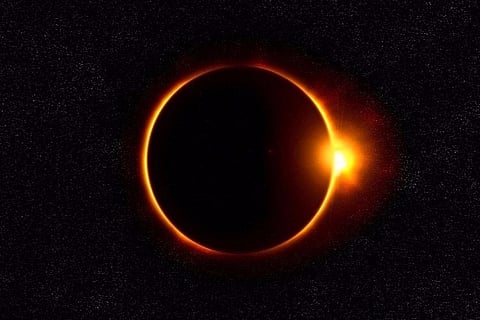

Stargazers in the US will be able to observe a "flower-like" structure during Monday's 'Great American Solar Eclipse', a team of physicists led by IISER-Kolkata said, on how the corona of the sun will look during the total solar eclipse.
The researchers say insights into the sun's coronal structure and diagnostics of the coronal magnetic field are important for space weather predictions linked to satellite operations and GPS navigation.
The eclipse will sweep across continental US, the first total solar eclipse in 99 years.
The sun is surrounded by a jacket of gases called an atmosphere. The corona is the outermost part of the sun's atmosphere.
The corona is usually hidden by the bright light of the sun's surface. That makes it difficult to see without using special instruments. However, the corona can be seen during a total solar eclipse.
Solar physicists at the Centre for Excellence in Space Science India (CESSI) at the Indian Institute of Science Education and Research, Kolkata, and Durham University predict the "presence of two prominent helmet streamers (i.e., petal-like closed magnetic field structures with pointed tips)."
".... one each in the Eastern and Western limb on the southern solar hemisphere and more diffused, low-lying, closed magnetic field structures with larger latitudinal spread on both the limbs in the northern hemisphere, of which the one in the West is more prominent," a statement from CESSI said on Monday.
What is referred to as the sun's West Limb is actually the right side of the sun as viewed from Earth and the sun's East limb is the left side of the sun viewed from Earth.
"A third possible helmet streamer which is quite narrow is seen in the West in the northern hemisphere. The latter is not easily distinguishable from the nearby diffuse structure in the synthetic white light corona, but may be more prominent further out from the sun", the statement said.
The team used a data driven solar surface flux transport model (a computational model with in-built memory over multiple years) for the effort.
The sun's coronal magnetic field is notoriously difficult to constrain and theoretical computational models must be relied upon for gaining insight on the coronal structure.
"These models are crucial to understanding the coronal heating problem (i.e., the enigma of the million degree solar corona) and to explore the origins of, and predict the occurrence of solar storms that create severe space weather. Space weather impacts our modern day technologies ranging from satellite operations, telecommunications, GPS navigational networks and electric power grids," the statement said.
The phenomenon from the US will be telecast live beginning around 9.30 p.m.
The team includes Dibyendu Nandi, Prantika Bhowmik, Suman Panda, Rajashik Tarafder, Soumyaranjan Dash from IISER-K and Anthony R. Yeates, from the Department of Mathematical Sciences, Durham University, Britain.
An independent prediction of the coronal structure was made by Predictive Sciences Inc. (USA), reportedly the only other group to have predicted the coronal structure of the upcoming solar eclipse, and who have a long and distinguished tradition of such predictions.
The last such eclipse occurred in 1918 when the path of totality crossed both the Pacific and the Atlantic coasts of the US.
A total solar eclipse occurs when the sun is completely obscured by the moon. The moon's diameter appears to be the same size as that of the sun, blocking out its light.
On Monday in one-and-a-half hours 14 states from Oregon to South Carolina stretched across a 112 km-wide swathe will experience night-like darkness for approximately two-and-a-half minutes in the middle of the day.